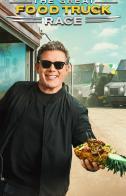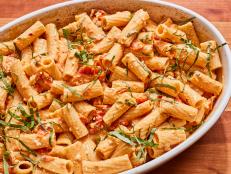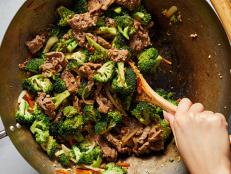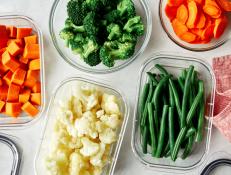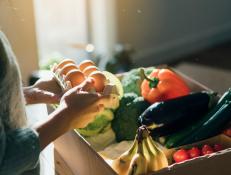How to Prevent 5 Common Cooking Mistakes, According to a Professional Recipe Developer
#3: Missing a step in the recipe.


Koldunova_Anna/Getty Images
Burnt fingers, charred quesadillas, underbaked blondies (and not the good kind of gooey) and "al-dente" potatoes: these are all kitchen mishaps from my last week of recipe development. I have been cooking professionally for eighteen years but these missteps happen to ALL of us. In the spirit of learning from my mistakes, I have come up with a few strategies over the years to help prevent some of the most common ones from happening in the first place.

Luca Melo/Getty Images
1. The Problem: Forgetting to Add an Ingredient (Or Adding It Twice)
The Solution: Measure Your Ingredients Before You Start Cooking
It would be great if we could all cook in quiet spaces where we could completely focus on cooking. But between hunger, kids, pets or just the daily news, that’s not reality. When we cook in a hurry or with distractions, it’s so easy to forget to add an ingredient or forget that we have already added it. Like the time I left the sugar out of brownies or doubled the salt in biscuit dough. I’ve learned to literally set myself up properly to avoid this mistake by creating mise en place. This French term, which translates to "put in place," is a key part of success in professional kitchens and works equally well in home kitchens. Gather all your ingredients for a recipe before you start cooking and arrange them in the order you need them. Ideally, you also want to measure everything out in separate dishes so you can just grab and add as you follow the recipe. Making mise en place might initially seem like extra work and dishes, but it makes the cooking process so much smoother, more relaxed and less prone to errors that it’s worth the effort.

Photographer, Basak Gurbuz Derman/Getty Images
2. The Problem: Food is Over- or Under-Cooked
The Solution: Pay Attention to Visual Cues of Doneness, Not Just the Time
Round two in the battle of cooking versus distractions is under- or over-cooked food. Here is where a small inexpensive tool, when used judiciously, can save your dish. It’s a timer. Test kitchen chefs love timers. We collect little stockpiles of our favorite ones and often have three going at the same time with one magnetized to the oven door, one hanging around our neck and one propped up on a cutting board.
The timing in our recipes is not an estimate. We literally test and retest every step with our faithful timers counting along and then pad in a slight range on either side to help account for different ovens, cook tops and pots and pans. However, the KEY thing about using a timer is that it’s a guide, not an absolute. Always defer to the visual cues in the recipe (such as "cook until brown and crispy on one side") to determine when it’s time to move on or declare the recipe done. If a recipe says to bake for 30 minutes, set your timer for 20 minutes and then go check on it. Does it look close to the visual cue for doneness? Add three to five more minutes. Still looking way off? Give it eight to ten more minutes. If it’s a recipe you love and will make again, you will know how to set the timer to a more precise time based on your personal variables (like how hot your oven is).
3. The Problem: Missing a Step in the Recipe
The Solution: Read the Recipe TWICE Before You Start Cooking
This was one of the first lessons hammered into me in culinary school and professional test kitchens. Why twice? Between the ingredients and the method, there is a lot of information to absorb in a recipe. The first read through will help you process the overall outline of the recipe. The second read through is where you notice the small details: the recipe calls for low-sodium soy sauce, hot paprika or dark brown sugar – not their similar but also difference-making counterparts. Maybe there is a four-hour marinade or two different brining steps. It’s easy for the eyes to skim or skip over a step, so reading the recipe all the way through twice helps catch it all. And it might sound old-school but writing out a start time and the times for each subsequent step can really simplify things and ensure you know the right time to start your recipe. I once planned totally wrong when making sourdough and realized I needed to get up at 2 a.m. to prevent under- or over-proofed loaves. It was not fun. Knowing what you are tackling, how long it will take and having the right ingredients will set you up for success.

yulkapopkova/Getty Images
4. The Problem: Scaling a Recipe Up or Down Doesn’t Go Well
The Solution: Calculate New Measurements and Write Them Down
Sometimes you want or need to double or halve a recipe. In addition to figuring out the right cooking vessel to use and adjusting the cooking times, there are the recipe quantities to figure out. Google and a good old scrap of paper and pencil are going to be essential here. Look up a cooking chart that lays out quantities in tablespoons and cups and go through the recipe writing down new measurements before you start cooking. To halve 1 tablespoon, use 1.5 teaspoons for accuracy. Also recognize that sometimes recipes don’t halve well. If you want to halve a recipe with 1 egg, you could crack the egg, beat it and try to estimate half the amount, but likely it’s better to either choose a different recipe, or just make the full amount. Baked pastas, muffins, loaf cakes, bread and raw cookie dough freeze like a champ. Consider it a gift to your future self.

Rebeca Mello/Getty Images
5. The Problem: You Followed the Recipe Exactly…But Weren’t Happy
The Solution: It’s Okay to Tweak Recipes — Trust Your Gut!
It’s pretty much impossible to create a recipe that every single person will find perfectly balanced and seasoned. What’s salty to one person is bland to another. And spiciness might be the most varied of all! Even the most popular and well received recipes tell the truth in the comments: "I loved it this and it’s perfect!" "I doubled the garlic and cheese." Or perhaps: "This was amazing! I followed the recipe exactly except I seasoned it at the end with fresh lime juice, hot sauce and chopped cilantro. 10 out of 10!" And guess what? We as recipe developers are here for IT! A recipe is a tool and a guide, but ultimately, as the cook, it’s OK to make those small adjustments to make it taste good to you. If you are feeling timid, then adjust and taste gradually until you get to where you like it. Not only will you enjoy the meal more, but also you will become a stronger and more confident cook.
Related Links:





